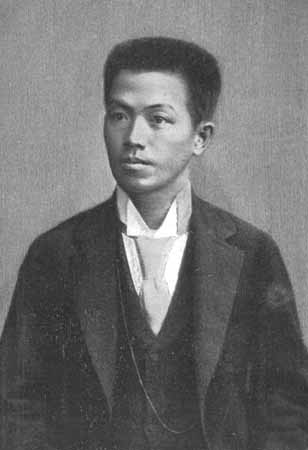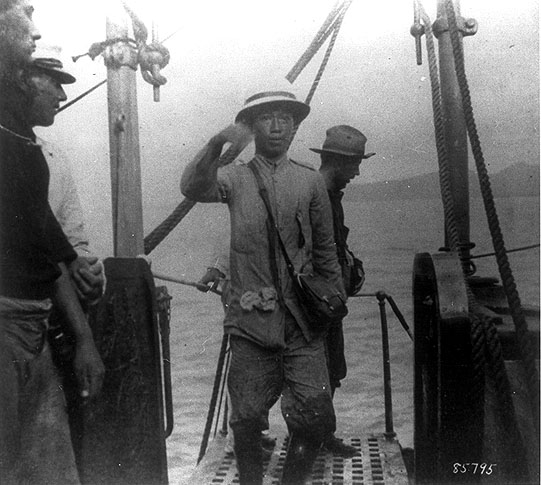<Back to Index>
- Physicist Robert A. Millikan, 1868
- Painter Anthony van Dyck, 1599
- President of the Philippines Emilio Aguinaldo y Famy, 1869


Emilio Aguinaldo y Famy (March 22, 1869 – February 6, 1964) was a Filipino general, politician, and independence leader of Chinese and Spanish descent. He played an instrumental role in Philippine independence during the Philippine Revolution against Spain and the Philippine-American War that resisted American occupation. He eventually pledged his allegiance to the US government. In the Philippines, Aguinaldo is considered to be the country's first and the youngest Philippine President. The seventh of eight children of Crispulo Aguinaldo and Trinidad Famy, he was born into a Filipino family on March 22, 1869 in Cavite El Viejo (now Kawit), Cavite province. His father was gobernadorcillo (town head), and, as members of the Chinese Tagalog mestizo minority, they enjoyed relative wealth and power. As
a young boy he received education from his great-aunt and later
attended the town's elementary school. In 1880, he took up his
secondary course education at the Colegio de San Juan de Letran, which he quit on his third year to return home instead to help his widowed mother manage their farm. At the age of 28, Miong, as he was popularly called, was elected cabeza de barangay of
Binakayan, the most progressive barrio of Cavite El Viejo. He held this
position serving for his town-mates for eight years. He also engaged in
inter-island shipping, travelling as far south as the Sulu Archipelago. In 1893, the Maura Law was
passed to reorganize town governments with the aim of making them more
effective and autonomous, changing the designation of town head from gobernadorcillo to capitan municipal effective 1895. On January 1, 1895, Aguinaldo was elected town head, becoming the first person to hold the title of capitan municipal of Cavite El Viejo. His first marriage was in 1896 with Hilaria Del Rosario (1877-1921). They had five children (Miguel, Carmen, Emilio Jr., María and Cristina). His second wife was María Agoncillo (1882-1963). In 1895, Aguinaldo joined the Katipunan, a secret organization led by Andrés Bonifacio,
dedicated to the expulsion of the Spanish and independence of the
Philippines through armed force. Aguinaldo used the nom de guerre Magdalo, in honor of Mary Magdalene. His local chapter of the Katipunan, headed by his cousin Baldomero Aguinaldo, was also called Magdalo. The
Katipunan revolted against the Spanish colonizers in the last week of
August 1896, starting in Manila. However, Aguinaldo and other Cavite
rebels initially refused to join in the offensive due to lack of arms.
Their absence contributed to Bonifacio's defeat in San Juan del Monte. While Bonifacio and other rebels were forced to resort to guerrilla warfare, Aguinaldo and the Cavite rebels won major victories in set-piece battles, temporarily driving the Spanish out of their area. Conflict between the Magdalo and another Cavite Katipunan faction, the Magdiwang,
led to Bonifacio's intervention in the province. The Cavite rebels then
made overtures about establishing a revolutionary government in place
of the Katipunan. Though Bonifacio already considered the Katipunan to be a government, he acquiesced and presided over elections held during the Tejeros Convention in Tejeros, Cavite on
March 22, 1897. Away from his power base, Bonifacio lost the leadership
to Aguinaldo, and was elected instead to the office of Secretary of the
Interior. Even this was questioned by an Aguinaldo supporter, claiming
Bonifacio had not the necessary schooling for the job. Insulted,
Bonifacio declared the Convention null and void, and sought to return
to his power base in Morong (present-day Rizal). He and his party were
intercepted by Aguinaldo's men and violence resulted which left
Bonifacio seriously wounded. Bonifacio was charged, tried and found
guilty of treason by a Cavite military tribunal, and sentenced to
death. After some vacillation, Aguinaldo confirmed the death sentence,
and Bonifacio was executed on May 10, 1897 in the mountains of
Maragondon in Cavite, even as Aguinaldo and his forces were retreating
in the face of Spanish assault. Spanish
pressure intensified, eventually forcing Aguinaldo's forces to retreat
to the mountains. Gen. Emilio Aguinaldo signed the treaty of
Biak-na-Bato, which specified that the Spanish would give self-rule to
the Philippines within 3 years if Gen. Emilio Aguinaldo was exiled. On
December 14, 1897, Aguinaldo was shipped to Hong Kong. Under the pact,
Aguinaldo agreed to end hostilities as well in exchange for amnesty and
"$800,000 (Mexican)" as
an indemnity. Aguinaldo took the money offered. Emilio Aguinaldo was
President and Mariano Trias (Vice President). Other officials included
Antonio Montenegro for Foreign Affairs, Isabelo Artacho for the
Interior, Baldomero Aguinaldo for the Treasury, and Emiliano Riego de
Dios for War. However,
thousands of other Katipuneros continued to fight the Revolution
against Spain for a sovereign nation. Unlike Aguinaldo who came from a
privileged background, the bulk of these fighters were peasants and
workers who were not willing to settle for 'indemnities.' In
early 1898, war broke out between Spain and the United States.
Aguinaldo returned to the Philippines in May 1898. He immediately
resumed revolutionary activities against the Spaniards, now receiving
verbal encouragement from emissaries of the U. S. The insurgent First Philippine Republic was formally established with the proclamation of the Malolos Constitution on January 21, 1899 in Malolos, Bulacan and endured until the capture and surrender of Emilio Aguinaldo to the American forces on March 23, 1901 in Palanan, Isabela, which effectively dissolved the First Republic. Aguinaldo appointed two premiers in his tenure. These were Apolinario Mabini and Pedro Paterno. The Malolos Congress continued its sessions and accomplised certain positive tasks. The Spanish fiscal system
was provisionally retained. The same was done with the existing taxes,
save those upon cockfighting and other amusements. War taxes were
levied and voluntary contributions were solicited. Customs duties were
established. A national loan was launched. President Aguinaldo ordered
schools open. Elementary education was made compulsory and free. The Filipino educator,
Erique Mendiola, founded the "Instituto de Burgos" and were appointed
by the Director of Public Instruction. It offered courses in
agriculture, surveying, and commerce, as well as a complete A.B course.
On October 1898 a government decree fixed the opening date of the
"Universidad Literia". Couses offered were Medicine, Surgery, Pharmacy, and Notary Public. The President of the Philippines appointed the professors thereof. They, in turn, chose the University rector. On the night of February 4, 1899, a Filipino was shot by an American sentry. This incident is considered the beginning of the Philippine-American War,
and open fighting soon broke out between American troops and
pro-independence Filipinos. Superior American firepower drove Filipino
troops away from the city, and the Malolos government had to move from
one place to another. Less than two years later, after the famous Battle of Tirad Pass with the death of Gregorio del Pilar, one of his most trusted generals, Aguinaldo was captured in Palanan, Isabela on March 23, 1901 by US General Frederick Funston, with the help of Macabebe trackers
(who saw Aguinaldo as a bigger problem than the Americans). The
American task force gained access to Aguinaldo's camp by pretending to
be captured prisoners. Aguinaldo pledged allegiance to America on April 1, 1901,
formally ending the First Republic and recognizing the sovereignty of
the United States over the Philippines. Nevertheless, many others (like Miguel Malvar and Macario Sakay) continued to resist the American occupation. During the United States occupation, Aguinaldo organized the Asociación de los Veteranos de la Revolución (Association
of Veterans of the Revolution), which worked to secure pensions for its
members and made arrangements for them to buy land on installment from
the government. When
the American government finally allowed the Philippine flag to be
displayed in 1919, Aguinaldo transformed his home in Kawit into a
monument to the flag, the revolution and the declaration of
Independence. His home still stands, and is known as the Aguinaldo Shrine. Aguinaldo
retired from public life for many years. In 1935, when the Commonwealth
of the Philippines was established in preparation for Philippine
independence, he ran for president but lost by a landslide to fiery
Spanish mestizo Manuel L. Quezon.
The two men formally reconciled in 1941, when President Quezon moved
Flag Day to June 12, to commemorate the proclamation of Philippine
independence. Aguinaldo again retired to private life, until the Japanese invasion of the Philippines in World War II.
He cooperated with the Japanese, making speeches, issuing articles and
infamous radio addresses in support of the Japanese — including a radio
appeal to Gen. Douglas MacArthur on Corregidor to surrender in order to spare the innocence of the Filipino youth. After
the Americans retook the Philippines, Aguinaldo was arrested along with
several others accused of collaboration with the Japanese. He was held
in Bilibid prison for months until released by presidential amnesty. In
his trial, it was eventually deemed that his collaboration with the
Japanese was made under great duress, and he was released. Aguinaldo
lived to see the recognition of independence to the Philippines July 4,
1946, when the United States Government fully recognized Philippine
independence in accordance with the Tydings-McDuffie Act of
1934. He was 93 when President Diosdado Macapagal officially changed
the date of independence from July 4 to June 12, 1898, the date
Aguinaldo believed to be the true Independence Day. During the
independence parade at the Luneta, the 93-year old former president
carried the flag he raised in Kawit. In 1950, President Elpidio Quirino appointed
Aguinaldo as a member of the Council of State, where he served a full
term. He returned to retirement soon after, dedicating his time and
attention to veteran soldiers' interests and welfare. He was given Doctor of Laws, Honoris Causa by the University of the Philippines in 1953. Aguinaldo died on February 6, 1964 of coronary thrombosis at the Veterans Memorial Hospital in Quezon City. He was 94 years old. His remains are buried at the Aguinaldo Shrine in Kawit, Cavite. When he died, he was the last surviving non-royal head of state (self-proclaimed) to have served in the 19th century.